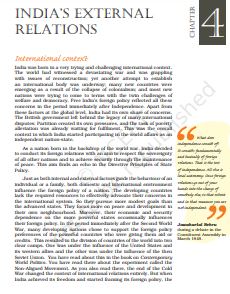‘NCERT Solutions for Class 12 Political Science Chapter 4‘ PDF Quick download link is given at the bottom of this article. You can see the PDF demo, size of the PDF, page numbers, and direct download Free PDF of ‘Ncert Class 12 Political Science Chapter 4 Exercise Solution’ using the download button.
NCERT Class 12 Political Science Textbook Chapter 4 With Answer PDF Free Download

Chapter 4: India’s External Relations
India was born in a very trying and challenging international context.
The world had witnessed a devastating war and was grappling with issues of reconstruction, yet another attempt to establish an international body was underway; many new countries were emerging as a result of the collapse of colonialism, and most new nations were trying to come to terms with the twin challenges of welfare and democracy.
Free India’s foreign policy reflected all these concerns in the period immediately after independence.
Apart from these factors at the global level, India had its own share of concerns. The British government left behind the legacy of many international disputes; partition created its own pressures, and the task of poverty alleviation was already waiting for fulfillment.
This was the overall context in which India started participating in world affairs as an independent nation-state.
As a nation born in the backdrop of the world war, India decided to conduct its foreign relations with an aim to respect the sovereignty of all other nations and to achieve security through the maintenance of peace.
This aim finds an echo in the Directive Principles of State Policy. Just as both internal and external factors guide the behavior of an individual or a family, both domestic and international environments influence the foreign policy of a nation.
The developing countries lack the required resources to effectively advocate their concerns in the international system. So they pursue more modest goals than the advanced states.
They focus more on peace and development in their own neighborhood. Moreover, their economic and security dependence on the more powerful states occasionally influences
their foreign policy.
In the period immediately after the second world war, many developing nations chose to support the foreign policy preferences of the powerful countries who were giving them aid or credits.
This resulted in the division of countries of the world into two clear camps.
One was under the influence of the United States and its western allies and the other was under the influence of the then Soviet Union.
You have read about this in the book on Contemporary World Politics. You have read there about the experiment called the Non-Aligned Movement.
As you also read there, the end of the Cold War changed the context of international relations entirely. But when India achieved its freedom and started framing its foreign policy.
| Author | NCERT |
| Language | English |
| No. of Pages | 18 |
| PDF Size | 12.6 MB |
| Category | Political Science |
| Source/Credits | ncert.nic.in |
NCERT Solutions Class 12 Political Science Chapter 4 India’s External Relations
1. Explain India’s Nuclear Policy.
Or
Explain four important features of India’s Nuclear Policy.
Answer: India’s Nuclear Policy:
1. India advocates no first use and reiterates India’s commitment to global verifiable non-discriminatory nuclear disarmament leading to a nuclear-weapon-free world.
2. Pt. Nehru always promoted science and technology so build a modern India i.e. initiated a nuclear program in the late 1940s under the guidance of Homi J. Bhaba.
3. India was against nuclear weapons, hence pleaded much nuclear disarmament with superpowers.
4. India always considered NPT discriminatory and refused to sign it.
5. Even India’s first Nuclear Test in May 1974 was termed as a peaceful explosion and India argued to use nuclear power for peaceful purposes only.
2. Describe any four issues of conflict between India and China.
Answer: Issues of Conflict between India and China:
(a) Serious conflict arose when China annexed Tibet in 1950 and removed a historical buffer between the two nations and India did not oppose this openly.
(b) India grew uneasy when China began to suppress Tibetan culture.
(c) Another border dispute arose when China claimed the Aksai Chin Area and NEFA (much of the state in Arunachal Pradesh) within the Indian territory.
(d) Despite long-term correspondence and discussions, these issues have not been resolved even by top leaders of the country.
(e) Hence, India had to indulge in the conflict.
3. Describe any two major issues of conflict between India and Pakistan leading to war of 1971.
Answer: Issues of conflict between India and Pakistan leading to War in 1971:
1. A serious armed struggle arose between India and Pakistan in December 1971 when Pakistan attacked Punjab and Rajasthan. In turn, India had to retaliate a war against Pakistan.
2. India had to bear 80 lakh refugees who fled from East Pakistan to take shelter in India. Hence, India had to extend moral and material support to the freedom struggle in Bangladesh against Pakistan.
4. What was the Tibet issue? How did it cause tension between India and China? Explain.
Answer: 1. From the very beginning of independence time to time, China has claimed its administrative control over Tibet.
2. In 1950, China took over control of Tibet. Large sections of the Tibetan population opposed this takeover.
3. In 1958, there was an armed uprising in Tibet against China’s occupation. India supported the cause of Tibet which was bitterly objected to by China. Even India has granted asylum to the Dalai Lama and a large number of Tibetans.
India’s External Relations NCERT Textbook With Solutions PDF Free Download
